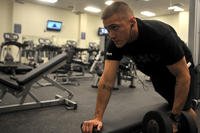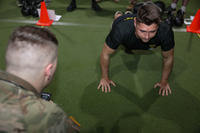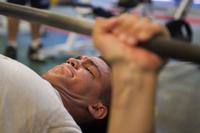Depending on your age, fitness level, goals and activity, there are many types of rest to consider.
There is active rest between sets, active rest between workout days and passive rest for both. All affect your ability to recover from previous rigorous activity. What is the right amount of rest for you?
Here is a list of several scenarios where options of rest occur every day:
1. Between weightlifting sets (active or passive rest)
Depending on your ability and goals, you can do either or mix the two options. If you are training to build strength and power, you may want to rest (sit and do nothing) between sets for 3-5 minutes (or longer in some real heavy lifting cases).
Here's an example:
Bench press -- 5 repetitions. Take a few minutes between this classic 5x5 lift routine. Typically, lifters will try to lift 75%-80% of their one-rep max (1RM) in the routine, and that requires recovery time to do the full five-repetition goal each set.
However, if you are not worried about your 1RM, you can mix in a few opposing muscle-group exercises and create a circuit and actively rest. You also could "rest with easy cardio" between sets. A short two- to three-minute bike or walk is considered an active rest.
Some "rests" require a higher level of fitness. If you're working upper-body exercises and then rest with lower-body exercises or cardio, you will rest your primary exercise but not your heart rate. After a hard set, there is nothing wrong with taking a water break and doing a light stretch for a more passive rest when needed.
2. Full-body workout days
These workouts typically work best in circuits with exercises arranged in opposing muscle-group order, working all body joints in one workout. Moving through these types of circuits, keep your heart rate high. This can be considered a higher-intensity workout because of the lack of passive rest.
For instance: See Circuit Training articles for training ideas. When you work everything in one day, you need to take a day in between as a "rest" day; active rest or passive rest is up to you and your abilities.
The rest comes into the workout week by taking a "rest day" between the full-body workout circuit days. Consider a mobility day between full-body days or add one if you are feeling burned out.
For instance, a Monday-Wednesday-Friday full-body circuit would be best balanced by a full rest or passive rest of easy cardio on Tuesday, Thursday and Saturday.
Take a full rest on Sunday unless you have housework and yard chores. That should be considered a passive rest, depending on the effort spent on Sunday chores.
3. Rest during cardio intervals
This can get complicated. Rest during cardio intervals depends on the effort level (speed and distance) as well as the event (run, swim, ruck, bike or other) and goals of the athlete.
Sprint intervals where you fun full speed require more rest. An active rest of walking, some dynamic stretches or sips of water between sets is a good active rest for 3-4 minutes (or more), but you need to stay warm to keep your muscle and tendon pliability between work sets.
If you are doing goal pace longer distance running, a work-to-rest ratio of 1:1 or 1:2 is a good range. If your goal pace is 90 seconds to run 400 meters and you want to maintain that pace for future timed runs, you may want to start limiting your rest to a 2:1 work-to-rest ratio as you progress. In this case, a run of 45 seconds, 90 seconds or 1:30 should be considered, depending on your current abilities, with the ultimate goal of hitting six sets in a row at 90 seconds for a nine-minute, 1.5-mile timed run pace.
Swimming sets are similar. Many people like to swim and rest on a timed interval. This means you swim a certain distance, such as 100 meters. For example: After swimming 100m, you do not have to start swimming again for the next set until 1:30. That means if you swim the 100m in 1:10, you get 20 seconds to rest before the next set. That is a passive rest that requires a quick ability to recover or the ability to recover not fully while still hitting your goal speed.
Regardless, these options depend on your goals and current conditioning, no matter what form of cardio you select to use for training.
This type of workout is set up and arranged for minimum rest. Build a PT pyramid like this: Pull-ups x 1, push-ups x 2, sit-ups or abs of choice x 3 (each set number)
(No rest -- your rest is the muscle group rest you get by doing other exercises)
Set #1: 1 pull-up, 2 push-ups, 3 sit-ups ...
Set #2: 2 pull-ups, 4 push-ups, 6 sit-ups ...
Set #3: 3 pull-ups, 6 push-ups, 9 sit-ups … and so on.
Work your way up the pyramid until you fail at something, then repeat in reverse order. As you can see, the pull, push, abs circuit arrangement allows for a form of active recovery. If you need to rest, take a short water and stretch break between sets.
5. Tabata cardio intervals
This is a classic work/rest interval that can be done with many types of exercises. It simply requires a 20-second, hard-work cycle -- followed by a 10-second, easy-work or rest cycle. Doing this for 5-7 minutes is very challenging, no matter what you are doing. Bike, elliptical, rowing, lifting, calisthenics or kettlebell movements can be used with the Tabata interval, though I prefer to use this interval for cardio options.
When people ask how much they should rest between sets (or during the workout week), the answer can be somewhat complicated from no rest, active rest or passive rest. The answer depends on your goals and personal abilities, as well as the events you are doing for training purposes. They all are needed in order to see improvement in performance results.
Stew Smith is a former Navy SEAL and fitness author certified as a Strength and Conditioning Specialist (CSCS) with the National Strength and Conditioning Association. Visit his Fitness eBook store if you're looking to start a workout program to create a healthy lifestyle. Send your fitness questions to stew@stewsmith.com.
Want to Learn More About Military Life?
Whether you're thinking of joining the military, looking for fitness and basic training tips, or keeping up with military life and benefits, Military.com has you covered. Subscribe to Military.com to have military news, updates and resources delivered directly to your inbox.
















